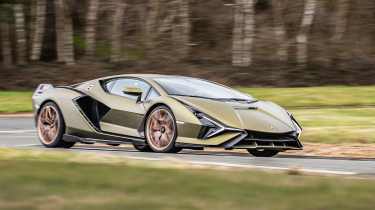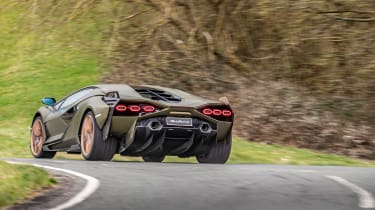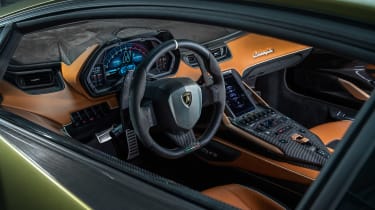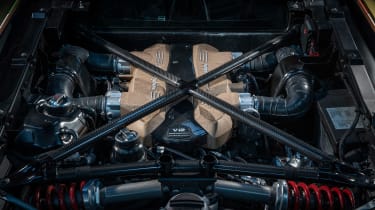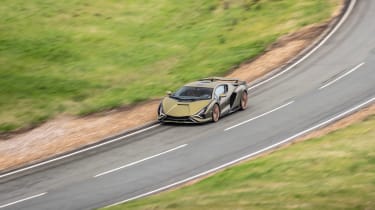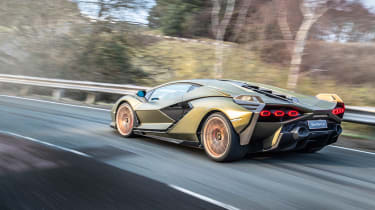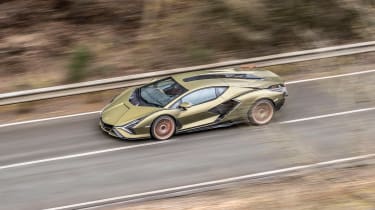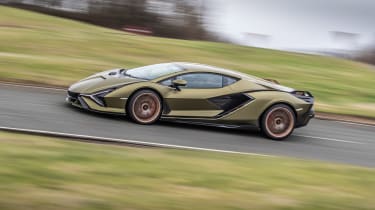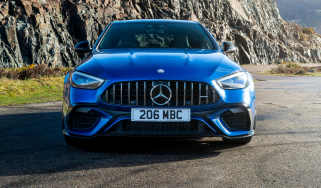Lamborghini Sian FKP 37 2021 review – a supercar with a supercapacitor
Lambo's sci-fi hybrid system works well, but the Sian is still a proper warts-and-all V12 Lamborghini
There will be just 63 Lamborghini Sian FKP 37s, and each one is sold out at £2.6m before taxes, so let’s call it a cool three million pounds and be done with it.
Based unashamedly on the Aventador SVJ, the Sian has been restyled by Lamborghini’s in-house designers under the guidance of its German boss, Mitja Borkert, who used to work at Porsche, and in the flesh it looks suitably extraordinary. You can tell it’s an Aventador beneath all the new fins and wings and multiple bits of carbon fibre, but only just.
The name Sian refers to flashes of lightning that appear in the skies above northern Italy, while “FKP 37” refers to one Ferdinand Karl Piech, who was born in 1937 and was in charge at VW when it assumed control of Lamborghini. Piech was many things to many people, but he was also a brilliant engineer at heart who constantly embraced the future, hence the Sian’s new hybridised version of Lamborghini’s now venerable 6.5-litre V12 engine.
Engine, transmission, 0-60mph time
The Sian’s V12 is no different internally from the SVJ’s monstrous 6.5-litre engine. It features exactly the same friction-reducing internals that help raise the SVJ’s output from 690bhp in the regular Aventador S to a more cacophonous 775bhp at 8500rpm, including its headline-making titanium intake valves. Not only does it rev higher and more freely than a regular Aventador’s V12, it’s louder too, thanks to a different exhaust system.
More reviews
Group tests
- Lotus Emira Turbo SE v Alpine A110 GTS – two of the last surviving mid-engined sports cars
- Alpine A290 v Alpine A110 – how much DNA do they really share?
- Ariel Atom 4R v Caterham Seven ‘evo25’: power-to-weight heroes go head-to-head
- Ariel Atom 4 v Caterham Seven 310R v Lotus Elise Cup 250
- £200,000 supercar shoot-out: AMG v Aston Martin v Maserati v McLaren
- Audi Quattro, RS2 and RS3: five-cylinder icons head-to-head
- Who makes the best GT car? Aston Martin v Bentley v Maserati
- Caterham Super Seven 600 v Super Seven 2000
- Corvette Stingray v Porsche Cayman GTS v Audi R8 RWD
- Great Ferrari hypercars driven: 288 GTO, F40, F50 and Enzo head-to-head
In-depth reviews
- Abarth 600e 2025 review – Italy gives the Alpine A290 something to worry about
- Alpine A110 review – the sports car Lotus should be building
- Aston Martin Vantage 2025 review – a thrilling Mercedes-AMG GT and 911 Turbo S alternative
- Audi R8 (2015 - 2024) review – the ultimate soft-focus supercar
- BMW iX 2025 review – the ugly duckling still stomps the Tesla Model X
Long term tests
- Abarth 695C Turismo Fast Fleet test – living with the charming Italian hatch
- Alfa Romeo Giulia Veloce long term test – can Italy beat Germany?
- Aston Martin Vantage (2006) Fast Fleet test – living with a £30k V8 Aston
- Caterham Seven evo25 Fast Fleet test – living with a track car for the road
- Caterham Seven evo Edition revealed – bespoke 420R joins the Fast Fleet
- Cupra Leon 300 Fast Fleet test – living with Spain's 300bhp hot hatch
- Cupra Ateca VZN Fast Fleet test – four months with Cupra's hot crossover
- Cupra Leon Estate 310 4Drive Fast Fleet test – living with the 306bhp hot estate
- Ford Mustang GT
- Ford Mustang GT
Review
- New Bentley Batur 2023 review – can it possibly be worth £1.65m?
- 2023 Chevrolet Corvette C8 Z06 review – the American 911 GT3?
- BBR Supercharged Mazda MX-5 (ND) 2023 review – tuned 250bhp roadster driven
- MG4 Trophy 2023 review
Reviews
- Abarth 695 75 Anniversario edition 2024 review – a fitting send-off for Abarth’s hot supermini?
- Abarth 500e 2023 review
- AC Cobra 378 Superblower MkIV 2021 review – another V8 Cobra, but with a GM heart this time
- Acura Integra Type S 2024 review – a Honda Civic Type R with added restraint
- Alfa Romeo Giulia review – get one while you still can
- Alfa Romeo 33 Stradale 2025 review – a rare Italian jewel beyond compare
- Alfa Romeo SZ: history, review and specs of an icon
The 7-speed gearbox is mostly the same, but for the fact that its casing also contains the new supercapacitor hybrid system. This adds 34kg (made back and then some by the use of carbonfibre elsewhere) but adds another 34hp (33bhp), hence Lamborghini’s claim that the system “delivers a remarkable weight to power ratio of 1.0kg/hp.”
Lamborghini also claims the hybrid system makes the Sian 10 percent quicker between 30-60kmh in third gear, and 20 percent between 70kmh (43mph) and 120kmh (75mph). That equates to a 1.2sec advantage over a car that isn’t exactly turgid in the mid-range.
Despite this, the zero to 62mph claim remains unchanged at 2.8sec, while the Sian’s top speed is quoted at “over 217mph” rather than merely 217mph for lesser Aventadors
Technical highlights
Technically, the Sian is all but the same car as the Aventador SVJ beneath the skin, but within its otherwise unchanged 7-speed automatic gearbox sits a small new electric motor that’s powered by a supercapacitor battery system, and all up this provides it with an additional 33bhp, giving 808bhp in total compared with 775bhp for the non-hybrid SVJ. Torque is rated the same as the SVJ at 530lb ft.
The battery recharges itself on the move via a regenerative braking system, which means there’s no plug-in element to the hybridisation. The extra power generated by the supercapacitor is deployed by the e-motor across all four wheels, and Lamborghini has designed the system primarily to fill the gaps between upshifts and smooth out the gear changes in the process. A bit like a zero-shift system in theory.
Elsewhere, the Sian is exactly the same as the Super Veloce Jota beneath the skin, although thanks to the extensive use of carbon fibre it actually weighs a few kilos less, with a quoted dry kerb weight of just 1600kg. So it has the same chassis, same four wheel steering, same carbon ceramic brakes, even the same interior give or take a flurry of fresh design touches, all of which are intended to make it feel as bespoke as possible inside without Lamborghini’s designers having to burn money by altering the fundamental architecture.
What’s it like to drive?
Pretty damn special to be honest, although there are numerous caveats that can’t be ignored. It wouldn’t be a genuine V12 Lamborghini were this not the case.
First thing you notice is the ride. It’s firm but extremely well damped. There is some calmness and control to the damping that you simply don’t expect from a Lamborghini that looks like this. At the same time, however, the throttle response isn’t wonderful when you first climb in and the Sian’s default drive modes are engaged. The gear changes are surprisingly shonky, in fact, as they always have been in Aventadors when left to their own devices in Strada/auto.
Switch to Sport mode and the throttle response becomes much more natural. The ride also gets firmer and noisier, but not necessarily worse, while the steering doesn’t feel much different, either, with a grainy precision that’s neither lovely nor awful. You want more feel through the rim, for sure, but there’s enough going on at your fingertips to keep you perfectly well informed about what’s happening down at the Sian’s big Pirelli front tyres. It’s just that the conversation isn’t sparkling.
The gear changes become crisper in Sport mode, on the other hand, although even then the gearbox is still not quite where you’d want it to be ideally. It lacks snap and clarity in this mode beside the best dual clutches, which is a pity.
It’s not until you select Corsa/manual that the darkest and best sides of the Sian reveal themselves. Then, and only then, does it begin to feel like it might just be worth the heinous amount of money it costs. Maybe…
The quality of the noise that comes out of the tail pipes and which fills the cabin as the V12 screams demonically up through 5000rpm to its 8500rpm cut out in second gear, is not something you will ever forget in a hurry. Quite apart from anything else it’s just very, very loud – to a point where even Greta Thunberg might just feel her beloved earth rotate a little more quickly were she ever fortunate enough to hear a Sian in full flow.
If anything it gets louder and more magnificent still when you shift to third and fourth and the engine takes that little bit longer to chew through the revs, giving you more time to appreciate the complexities – and sheer volume – of the sounds it emits.
The acceleration the Sian produces in its lower gears is also completely ridiculous, physically uncomfortable, even, when experienced within the confines of a public road. This makes the Sian’s biggest vein of performance a rather wonderful thing not to unleash for much of the time, because you know it’s there and will freak you right out when you want it to. A little bit like a nuclear deterrent I imagine.
Subjectively the e-motor does seem to fill the gaps nicely between the ratios, too, smoothing out full bore upshifts where lesser Aventadors deliver an unwanted thump to the back of the head under the same loads. The gearbox, in Corsa/manual, does work beautifully it must be said.
Yet it’s what happens to the chassis and steering in Corsa/manual that arguably leaves the longest and deepest impression of all. In this respect, it’s quite astonishing how the Sian’s core personality can be altered so radically – and so successfully – at the press of just two little buttons. It’s a serious Jekyll and Hyde transformation that takes place, to a point where it feels quite a lot like a full-blown competition car in Corsa/manual, but one that’s still just about usable on the road with a bit of imagination.
Don’t think the Sian can’t do body control or turn in precision, either, or that it doesn’t really stop properly because it’s still just a big old Lambo at heart, one that falls apart at the seams if you ask it the more difficult questions. Wrong.
In Corsa mode the Sian is extremely stiff, yes, but it’s also millimetrically precise in its responses and has pretty much total traction in the dry. Its big body is wide but not at all clumsy in its control, and its vast carbon brakes have immense power and feel when you use them hard.
As such you can drive it, really lean on it more than you might imagine possible. To be honest there’s not much I can think of here and now that would be capable of staying with it on a road like this. It’s that quick, that sorted, that dramatically effective at covering ground – so long as you’re in the right mood for it, and the car itself is in the right settings. Which is probably the most surprising thing of all to discover about the Lamborghini Sian, given how much of a peacock it would appear to be on the surface.
Price and rivals
At £2.6m before local taxes are applied, the Sian realistically costs at least three million pounds. Yet its price is almost of no consequence to the sort of customers who bought all 63 examples the moment they went on sale in 2019, because in all likelihood this car’s value will rise, not fall over time. So although it costs broadly the same as a Bugatti Chiron and is not anywhere near as radical as that car technically, in the future it may well be worth more due to its limited numbers.
Lamborghini will also produce 19 Sian Roadsters that will cost even more money than the 63 coupes, and all of those have already sold out, too, ensuring that the gap between the haves and the have nots in this world has grown wider still.
